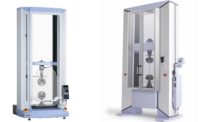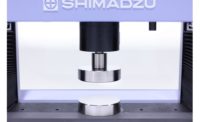Back to Basics: Impact Testing
Beginner tips to understand impact test methods and standards.

In automotive and other safety-critical industries, impact testing is an important measure of a material’s failure properties. Properly testing both raw materials and molded components for their strength and durability can help engineers prevent failures, design lasting goods, and save lives.
A proper understanding of a material’s potential for degradation and damage and its responses to stress and aging is key for the entire supply chain and product lifecycle, from maintaining batch quality during the raw material’s creation, to the design engineer properly choosing and integrating the material into a design.
“The check point in material strength evaluation that has conventionally been only static strength has expanded to include the scope of impact fracture properties,” according to Shimadzu. “The impact fracture properties of materials are also used in the selection of product materials and in fundamental data for quality control, being greatly applied for the purpose of improving R&D efficiency and product reliability.”
Impact testing is also important for plastics used in applications that are not safety critical, such as consumer electronics like video game controllers and other hand-held devices that are regularly dropped, mashed and otherwise submitted to daily stress.
Types of Tests
The first impact tests were of the pendulum variety, such as the Charpy and Izod methods, which are still used today. The pendulum is hoisted and allowed to swing towards impact with the test specimen. In both traditional Charpy and Izod tests, the pendulum strikes a notched specimen. Engineers are able to calculate the impact energy by using the known weight and set height of the pendulum, calculated against the return distance traveled by the pendulum when it swings back after impact. It’s a simple and straight-forward process, but generally only applicable for raw materials, rather than molded components and parts. This test is conducted to catastrophic failure of the specimen.
Drop weight impact tests are another method. In the test, a weighted striker drops straight down between rails towards the specimen or part. The process has an advantage over pendulum swing tests in that it can be conducted on molded components and parts, in addition to raw specimens. The specimen failure can be unidirectional, and fractures and other non-complete failures are able to originate at the weakest point of the specimen. Traditionally, drop weight tests were not generally conducted to total specimen failure.
“They’re not trying to find out absorbed energy, they’re trying to find out damage based on impact,” Joshua M. Duell, an asset integrity engineer in the oil and gas industry, said in a phone interview. “An aircraft might get hit by a hailstone or something, so you would do a drop weight impact test to find out what kind of damage that would cause.”
With some materials such as carbon fiber reinforced plastics, the engineer needs to then quantify that damage through the layers by looking inside with ultrasonic phased array or other secondary inspection. “You can quantify what the damage is on the outside, but that doesn’t necessarily translate all the way through if you have a thick layer of composite,” he said.
Today, sophisticated electronic sensing instrumentation applied to either type of test can provide additional impact information well above and beyond what was possible in previous eras. This is especially important when discovering hairline cracks or fractures that, though invisible to the human eye, could lead to a complete, critical failure down the road. Oftentimes, as mentioned, further analysis is required following the impact test, especially to investigate those barely visible or invisible fractures. Ultrasound, microwave testing and compression testing are common options.
Time, cost and availability of the post-test method are taken into consideration when choosing the best method, Duell wrote in chapter 6, “Impact Testing of Advanced Composites,” of the book Advanced Topics in Characterizations of Composites. “In the case of … drop weight impact test specimen, one may want to characterize the strength left in the composite,” he wrote. “Therefore, a compression test may need to be done to the specimen. The post-impact test technique for a laminated plate may be either qualitative or quantitative. Non-destructive testing is qualitative and shows the damage caused by impact testing. Destructive testing is quantitative and will give the material properties (such as modulus, stress, strain, etc.) of the composite after impact. If necessary, both types of testing can be done, provided the ND technique is done first.”
Standards
ISO, JIS and ASTM provide standards for impact testing, but the focus below is ASTM D3763, “Standard Test Method for High Speed Puncture Properties of Plastics Using Load and Displacement Sensors.”
There are several other ASTM standards for impact testing a variety of materials using a variety of methods. These include but are not limited to D1709, “Standard Test Methods for Impact Resistance of Plastic Film by the Free-Falling Dart Method;” D2463, “Standard Test Method for Drop Impact Resistance of Blow-Molded Thermoplastic Containers;” and D6110, “Standard Test Method for Determining the Charpy Impact Resistance of Notched Specimens of Plastics,” etc.
In D3763, for example, ASTM requires the operator to test at least five specimens at each specified speed. To conduct the test, each specimen is loaded either manually or automatically into the specimen holder. The range of speeds appropriate for testing depends on the material and application. As the punch striker deforms the specimens, an oscilloscope, data logger, or computer-based data acquisition system records the deformation.
Looking for a reprint of this article?
From high-res PDFs to custom plaques, order your copy today!






